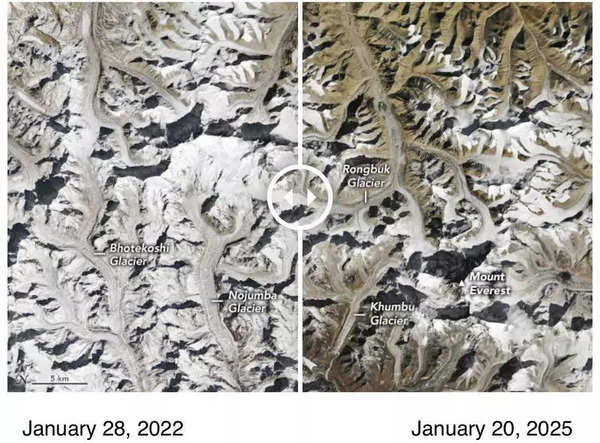DEHRADUN: In less than two months, the snow line in the glaciated landscape around Mt Everest rose by 490 feet, from 20,000 ft on Dec 11 last year to 19,510 ft on Jan 28, due to sublimation—a process in which strong winds, low humidity, and unseasonably warm temperatures cause snow to evaporate directly into the atmosphere, scientists observed.

Nasa’s satellite images point to a long-term shift in snowfall patterns
Glaciologist Mauri Pelto, a member of Nasa Earth Observatory’s science advisory board, detected the change while studying Everest-region glaciers through satellite imagery and local weather stations.
Scientists say warmer, drier conditions are pushing the winter snow line higher, meaning seasonal snow now remains only at greater elevations. Satellite imagery from Nasa’s Landsat 9, captured on Jan 20, confirmed this upward retreat, contrasting with typical snow distribution seen in Jan 2022.
Experts said the sparse lower-elevation snow, as seen this Jan, has become the norm in recent winters. Pelto said this trend has persisted in recent years, suggesting a “new normal” for the region. “This change was due to sublimation, not melting,” he added. The snowline was already above average at the start of winter, following a dry beginning to 2024 and an unusually warm and wet post-monsoon season.
Pelto added that 2022 was the only recent year when Jan snow lines remained at typical levels. However, the elevated snow lines seen in Jan 2021, 2023, 2024, and 2025 point to a long-term shift in snowfall patterns. Unlike North American and European glaciers, which gain mass from winter snowfall, Himalayan glaciers primarily accumulate snow during summer, making dry winter months particularly critical. Approximately 75% of the annual precipitation falls during the monsoon from June to Sept, during which these glaciers accumulate the most snow. If the snow persists long enough, it can eventually transform into glacial ice.
Experts warn that the winter snow line in the Himalayas reaching unprecedented elevations could threaten water security for downstream communities and increase wildfire risks, as seen in Nepal’s early 2025 fire season.


